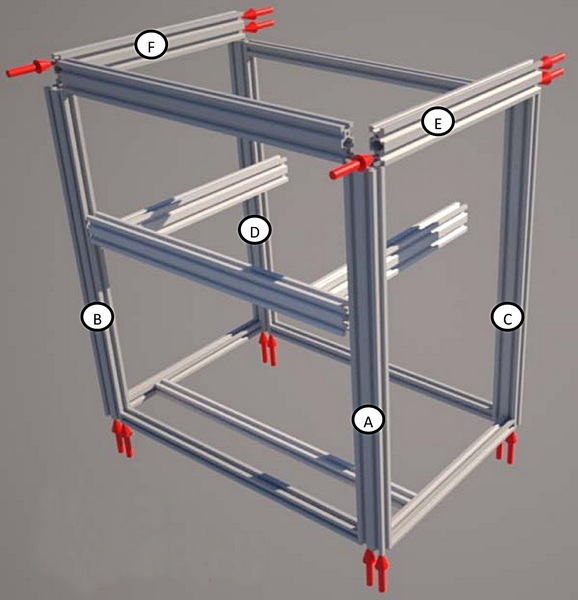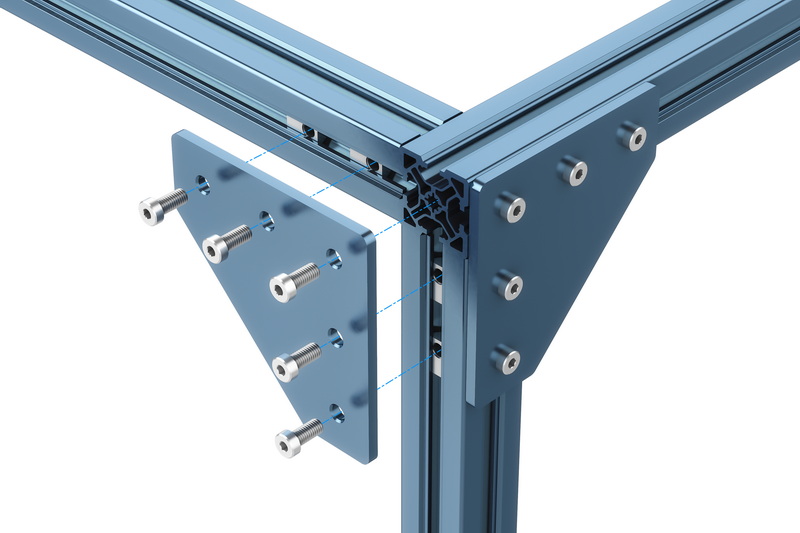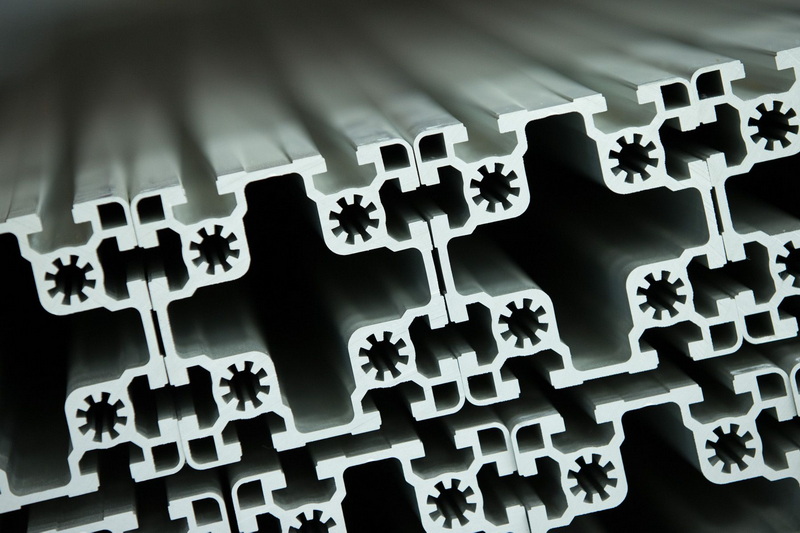Content Menu
● Understanding Aluminum Extrusion Framing
>> Benefits of Aluminum Extrusion Framing
● Steps to Design a Custom Structure
>> Step 1: Define Your Project Requirements
>> Step 2: Choose the Right Aluminum Extrusion Profiles
>> Step 3: Create a Design Plan
>> Step 4: Assemble the Structure
>> Step 5: Finishing Touches
● Practical Applications of Aluminum Extrusion Framing
>> Step 6: Consider Safety and Compliance
>> Step 7: Test Your Structure
● Tips for Successful Design
● Conclusion
>>
● Frequently Asked Questions
>> 1. What tools do I need to work with aluminum extrusion framing?
>> 2. Can I use aluminum extrusion framing for outdoor projects?
>> 3. How do I ensure my structure is stable?
>> 4. Is aluminum extrusion framing cost-effective?
>> 5. Can I modify my design after assembly?
Understanding Aluminum Extrusion Framing
Designing a custom structure using aluminum extrusion framing is an exciting venture that combines creativity with engineering principles. Aluminum extrusion framing is a versatile and lightweight material that can be used in various applications, from industrial machinery to home projects. This article will guide you through the process of designing a custom structure, covering everything from the basics of aluminum extrusion to practical design tips and considerations.
Aluminum extrusion is a manufacturing process that involves shaping aluminum alloy into a desired cross-sectional profile. This process allows for the creation of complex shapes that can be used in various applications. The resulting aluminum extrusions are lightweight, strong, and resistant to corrosion, making them ideal for structural applications.

Benefits of Aluminum Extrusion Framing
1. Lightweight: Aluminum is significantly lighter than steel, making it easier to handle and transport.
2. Corrosion Resistance: Aluminum naturally forms a protective oxide layer, which helps prevent corrosion.
3. Versatility: Aluminum extrusions can be easily cut, drilled, and assembled, allowing for a wide range of designs.
4. Sustainability: Aluminum is recyclable, making it an environmentally friendly choice for construction.
Steps to Design a Custom Structure
Step 1: Define Your Project Requirements
Before diving into the design process, it's essential to define the requirements of your project. Consider the following questions:
- What is the purpose of the structure?
- What are the dimensions and weight requirements?
- Will the structure be permanent or temporary?
- What environmental factors will it be exposed to (e.g., weather, load)?
Defining these parameters will help you create a focused design that meets your specific needs. For instance, if you are designing a temporary display for a trade show, you might prioritize lightweight materials and ease of assembly. Conversely, a permanent structure may require more robust profiles and additional considerations for load-bearing capacity.
Step 2: Choose the Right Aluminum Extrusion Profiles
Selecting the appropriate aluminum profiles is crucial for the success of your project. There are various profiles available, including:
- T-Slot Profiles: These profiles allow for easy assembly and disassembly, making them ideal for modular designs.
- Square and Rectangular Tubes: These provide excellent structural integrity and are suitable for frames and supports.
- L-Shaped and U-Shaped Profiles: These can be used for brackets and supports.
When choosing profiles, consider the load they will bear and the overall design aesthetic. T-slot profiles, for example, are popular for their flexibility and ease of use, allowing for quick adjustments and modifications.
Step 3: Create a Design Plan
Once you have defined your project requirements and selected the appropriate profiles, it's time to create a design plan. This plan should include:
- Sketches or CAD Drawings: Visual representations of your design will help you visualize the final product.
- Material List: A comprehensive list of all the materials needed, including profiles, connectors, and fasteners.
- Assembly Instructions: Step-by-step instructions on how to assemble the structure.
Using CAD software can significantly enhance your design process. It allows for precise measurements and the ability to visualize the structure in 3D, making it easier to identify potential issues before assembly.
Step 4: Assemble the Structure
With your design plan in hand, you can begin assembling your custom structure. Here are some tips for a successful assembly:
- Use the Right Tools: Ensure you have the necessary tools, such as a saw, drill, and wrenches, to work with aluminum extrusions.
- Follow Your Design Plan: Stick to your assembly instructions to ensure the structure is built correctly.
- Check for Squareness: As you assemble, regularly check that the structure is square and level to avoid any misalignments.
Proper assembly techniques are crucial for ensuring the stability and longevity of your structure. For example, using corner brackets can enhance the rigidity of joints, while ensuring that all fasteners are tightened to the manufacturer's specifications will prevent any structural weaknesses.

Step 5: Finishing Touches
After assembling the structure, consider adding finishing touches to enhance its appearance and functionality. This may include:
- Surface Treatments: Anodizing or powder coating can improve the aesthetic appeal and corrosion resistance of the aluminum.
- Accessories: Adding shelves, brackets, or other accessories can increase the functionality of your structure.
Finishing touches not only improve the look of your structure but can also enhance its durability. For instance, anodizing provides a hard, protective layer that can withstand harsh environments, making it ideal for outdoor applications.
Practical Applications of Aluminum Extrusion Framing
Aluminum extrusion framing can be used in various applications, including:
- Industrial Workstations: Custom workstations can be designed to fit specific tasks and workflows, improving efficiency and ergonomics.
- Display Stands: Retail displays can be created using aluminum extrusions for a modern look that attracts customers.
- Automated Systems: Aluminum framing is often used in robotics and automation for its lightweight properties, allowing for faster movement and easier integration.
- Furniture: Custom furniture pieces can be designed using aluminum extrusions for a sleek, modern aesthetic that is both functional and stylish.
Step 6: Consider Safety and Compliance
When designing and constructing your custom structure, it's essential to consider safety and compliance with local building codes. Depending on the application, you may need to adhere to specific regulations regarding load-bearing capacities, fire safety, and accessibility. Consulting with a structural engineer can provide valuable insights and ensure that your design meets all necessary standards.
Step 7: Test Your Structure
Before putting your custom structure into full use, it's wise to conduct tests to ensure its stability and functionality. This may involve:
- Load Testing: Gradually applying weight to the structure to ensure it can handle the intended loads without deformation or failure.
- Stability Testing: Checking for any wobbling or instability, especially if the structure will be used in a high-traffic area.
Testing your structure can help identify any potential weaknesses and allow for adjustments before it is put into service.
Tips for Successful Design
1. Plan for Adjustability: Consider designing your structure to be adjustable, allowing for future modifications. This is particularly useful in environments where needs may change over time.
2. Incorporate Modular Elements: Using modular components can make it easier to expand or change your design later. This flexibility can save time and resources in the long run.
3. Test Your Design: If possible, create a prototype of your design to test its functionality and stability before finalizing it. Prototyping can reveal design flaws that may not be apparent in the planning stages.
Conclusion
Designing a custom structure using aluminum extrusion framing is a rewarding process that allows for creativity and innovation. By understanding the benefits of aluminum, selecting the right profiles, and following a structured design process, you can create a functional and aesthetically pleasing structure tailored to your needs. Whether for industrial applications, retail displays, or custom furniture, aluminum extrusion framing offers endless possibilities for design and functionality.

Frequently Asked Questions
1. What tools do I need to work with aluminum extrusion framing?
- You will need a saw, drill, wrenches, and measuring tools to cut and assemble aluminum extrusions.
2. Can I use aluminum extrusion framing for outdoor projects?
- Yes, aluminum is resistant to corrosion, making it suitable for outdoor applications. However, consider using anodized or powder-coated finishes for added protection.
3. How do I ensure my structure is stable?
- Use appropriate connectors and fasteners, and regularly check for squareness during assembly to ensure stability.
4. Is aluminum extrusion framing cost-effective?
- While the initial cost may be higher than some materials, the durability and low maintenance of aluminum can make it a cost-effective choice in the long run.
5. Can I modify my design after assembly?
- Yes, one of the advantages of aluminum extrusion framing is its modularity, allowing for easy modifications and adjustments.






















